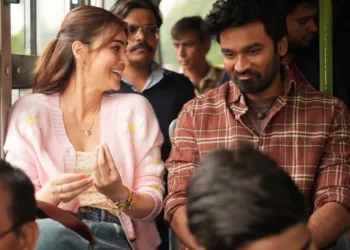In an unprecedented triumph for regional cinema, “Roi Roi Binale” has shattered every conceivable box office record for Assamese films, crossing the ₹25 crore mark within just two weeks of release. The posthumous film of beloved artist Zubeen Garg has transformed from a cinematic release into a cultural phenomenon, with theatres becoming spaces of collective mourning, celebration, and regional pride. This musical drama isn’t merely breaking records—it’s rewriting the commercial possibilities of Assamese cinema.
Table of Contents
Roi Roi Binale Box Office Breakdown
| Metric | Details |
|---|---|
| Opening Day Collection | ₹2.52 crore (Official) |
| First Week Total | ₹16 crore approximately |
| Two Week Collection | ₹25+ crore (India net) |
| Budget | ₹5 crore |
| ROI in Two Weeks | Over 400% |
| Total Screens | 180+ across India |
| BookMyShow Sales | 7+ lakh tickets |
| Projected Lifetime | ₹40-50 crore |
A Historic Opening That Stunned Trade Analysts
When Roi Roi Binale premiered on October 31, 2025, it created history with a ₹2.52 crore opening day—nearly triple the previous Assamese cinema record. The film enjoyed 98% occupancy across theatres, with shows beginning as early as 4:25 AM in Guwahati and continuing past midnight. Several long-shuttered theatres reopened specifically for this release, while operational venues scheduled up to seven shows daily to meet overwhelming demand. The emotional connection ran so deep that fans arrived with flowers and photographs, transforming screenings into tribute sessions for the late artist who passed away in Singapore just before the release.

The dedication extended beyond Assam’s borders. Cities including Lucknow, Pune, Dehradun, Bhubaneswar, Jaipur, and Goa hosted special screenings, marking the widest-ever release for an Assamese production. According to Sacnilk’s box office tracker, the film maintained extraordinary consistency throughout its first week, dropping minimal collections on weekdays—a rarity that signals genuine audience love rather than mere opening weekend curiosity. In Guwahati alone, the film grossed nearly ₹1 crore daily during its peak, dwarfing previous regional champions like “Jawan” and “Pushpa 2,” which maxed out at ₹65 lakhs in the same market.
For more regional cinema success stories, explore our Indian box office analysis section on TechnoSports.
The Man Behind The Phenomenon
Zubeen Garg wasn’t just an actor in Roi Roi Binale—he was its soul. The multitalented artist served as writer, director, composer, and lead performer, pouring his artistic vision into Assam’s first-ever musical feature film. The narrative follows a blind musician whose journey mirrors Garg’s own philosophical questions about art’s purpose and an artist’s place in society. With over 15 original compositions, breathtaking cinematography shot in Sri Lanka using anamorphic lenses, and Dolby Atmos sound mixing, the film introduced technical firsts to Assamese cinema while maintaining deep cultural authenticity.
The title track features Italian opera singer Gioconda Vessichelli, symbolizing Garg’s ambition to elevate regional cinema onto global platforms. The song “Roi Roi Binale” itself originated from his iconic 1998 album “Sabda,” creating a poignant full-circle moment in his artistic journey. His passing before the release transformed the film from entertainment into an emotional pilgrimage, with the Assam government announcing it would donate its entire GST share from the film to Garg’s Kalaguru Artiste Foundation, which supports medical treatment for artists and aids flood victims. You can learn more about Zubeen Garg’s musical legacy through his extensive discography and filmography.
Check out more entertainment news and celebrity tributes on our entertainment coverage page.
Breaking Barriers And Building Legacies
What makes Roi Roi Binale’s success particularly remarkable is its dominance over mainstream releases. Every cinema hall across Assam exclusively screened this film during its opening week, suspending holdover titles including “Kantara: Chapter 1” and postponing newer releases like “Baahubali: The Epic.” This unprecedented industry solidarity demonstrated the film’s cultural significance beyond commercial considerations. Trade analysts initially projected a lifetime collection of ₹8-9 crore, but the film surpassed that figure within days, becoming the highest-grossing Assamese film ever by its first weekend.
The momentum shows no signs of slowing. With consistent daily collections and sustained occupancy rates, industry insiders now believe the film could realistically target ₹40-50 crore, figures previously unimaginable for regional cinema. If it maintains theatrical presence for two months—similar to previous Assamese hits like “Bidurbhai” and “Bhai Mon Da”—it could establish new benchmarks that reshape how regional films are financed, distributed, and marketed across India. The production team deliberately chose to release comprehensive financial details only after one month, acknowledging that this period transcends mere box office calculations.
Discover more about regional cinema’s rising influence on our regional films spotlight section.

Understanding The Emotional Tsunami
Beyond numbers and records lies a deeper story about collective grief channeled through cinema. Fans didn’t just watch Roi Roi Binale—they experienced catharsis. Many viewers reported leaving theatres in tears, having spent two hours with an artist who defined their cultural identity. Social media platforms overflowed with emotional tributes, with people sharing how Garg’s music and films shaped their lives. The film became a communal space where thousands could simultaneously celebrate his legacy while processing their loss, creating a unique phenomenon where box office success measured love rather than mere entertainment value.
The Assam Congress president urged the state government to make the film tax-free as a tribute, though Chief Minister Himanta Biswa Sarma noted that no entertainment tax exists in the state. Nevertheless, the government’s decision to donate GST revenues to Garg’s foundation ensured his charitable work continues benefiting struggling artists and needy students—a fitting tribute to a man who used his platform for social good throughout his life. This gesture transformed commercial success into social impact, creating a blueprint for how regional cinema can honor departed artists while supporting their communities.
Why has Roi Roi Binale achieved unprecedented success compared to previous Assamese films?
The film’s extraordinary performance stems from a perfect convergence of artistic excellence, emotional timing, and cultural significance that transcended typical movie-going experiences. Zubeen Garg represented more than entertainment to Assamese audiences—he embodied their cultural pride, artistic aspirations, and regional identity for decades through his music and films. His unexpected passing created a collective grief that needed expression, and Roi Roi Binale provided that outlet. The fact that this represented his final artistic statement, where he served as writer, director, composer, and lead actor, made it feel like a farewell letter to his audience. Additionally, the film’s technical achievements, including being shot with anamorphic lenses and mixed in Dolby Atmos, demonstrated that regional cinema could match international production standards. The exclusive theatrical release across Assam created urgency and unity, transforming individual viewings into a shared cultural moment. This combination of emotional resonance, technical quality, and communal experience created box office momentum that traditional marketing budgets could never manufacture, proving that authentic cultural connections remain cinema’s most powerful asset.
What does Roi Roi Binale’s success mean for the future of regional Indian cinema?
This blockbuster’s performance fundamentally challenges assumptions about regional cinema’s commercial viability and audience reach. For years, regional films were considered niche products with limited earning potential, but Roi Roi Binale demonstrated that culturally rooted stories told with technical excellence and emotional authenticity can generate returns rivaling mainstream productions. With a ₹5 crore budget achieving over 400% return on investment within two weeks, the film proves that regional cinema doesn’t require pan-Indian appeal or massive budgets to succeed spectacularly. This success will likely encourage investors to back ambitious regional projects, give filmmakers confidence to tell authentic local stories without diluting cultural specificity, and inspire other regional industries to aim higher in production values and narrative ambition. The film’s performance on BookMyShow’s national charts, despite limited geographical release, shows that regional content can capture national attention when quality and emotional resonance align. Perhaps most importantly, it demonstrates that audiences hunger for genuine cultural experiences over homogenized content, suggesting that regional cinema’s future lies not in imitating mainstream formulas but in celebrating what makes each culture unique while maintaining world-class technical standards.








